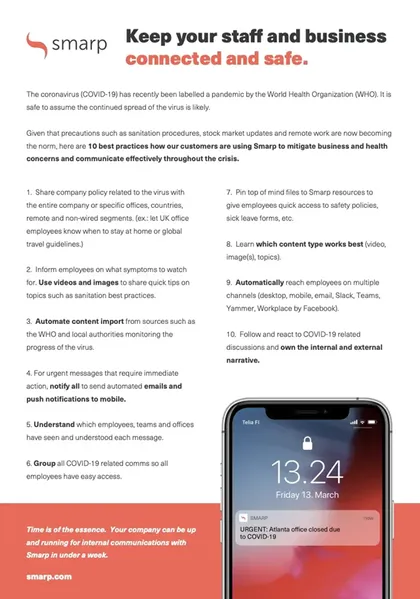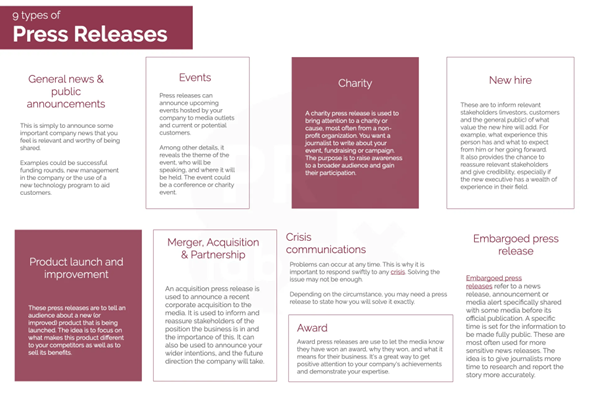Your company receives a barrage of bad reviews for a new product release.
Customers are complaining about the product's quality, functionality, and customer service response. This flood of criticism is quickly gaining traction online, damaging your reputation and sales.
Cue Corporate Communications Department.
They quickly reach out to all the customers personally, send a gift card, and a personalized message, “Dear [Customer's Name], Your feedback is crucial. We're actively resolving issues and here to assist you promptly.”
They then ask the product team to revise the product based on feedback, monitor customer comments on social media, and ensure any lingering problems are resolved ASAP.
Crisis averted.
From employees and executives to external stakeholders, corporate communications involves keeping everyone happy and maintaining a positive image of the company.
So what exactly is corporate communications and why do organizations need a robust corporate comms department and strategy? Let’s find out.
What is Corporate Communications?
Corporate communications provides the framework in which all other departments communicate, both internal and external.
It’s main goal? Build and keep good relationships with the people and groups that are important to the organization, i.e, customers, collaborators, investors, the community, and even government authorities.
In short, corporate communications contribute to maintain a positive reputation in front of everyone.
4 Main Functions of The Communications Department
Depending on the goals and needs of an organization, communications roles, departments and the overall structure differs from one to another.
While some may have separate departments for internal and external communications, others may have a single staff person overseeing everything. There's no one-formula that fits all.
But, there are some core functions of the communications department that most organizations need. We will break them down into four points:
Internal Communication
Training employees. Collecting feedback. Internal conflicts and crises management. Assisting leadership in organizational goals. Increasing employee engagement and retention via various strategies.
Communication within the organization is a core function of the corporate communications department.
The main goal is to achieve alignment and ensure engagement inside the organization to meet organizational goals. It also serves as an information hub, relaying information from corporate communication internally.
For example, if the boss plans on layoffs or announces a hybrid work policy, it is the role of this department to relay this information and ensure a flawless experience.
Similarly, during times of crisis, like the notorious COVID 19 crisis, it is this department's responsibility to manage the crisis internally while other departments manage its external stakeholders. It will be your ally in keeping your staff informed and engaged.
Public Relations aka External Communication
The bigger the organization, the more stakeholders it has - i.e., governing bodies, investors, funding sources, and the public.
The Public Relation department’s responsibility is to manage a positive image in front of all the stakeholders via press releases, social media marketing campaigns, sponsorships, events, and media pitches.
And bad PR can cost an organization a lot of money, too. The Cambridge Analytica scandal, where Facebook was accused of allowing third parties to access users' personal information, cost them $725 million.
Public relation, or external communications, responsibilities include,
Managing the reputation and relationship with all stakeholders - whether that’s the media or the governing bodies.
Ensuring no harm comes to the company’s image in crisis management.
Sending the right messages and updates to stakeholders during a crisis.
Handling media relations to secure positive coverage.
Promoting brand’s image through various activities, campaigns, events, sponsorships, etc.
Customer communication
Customer communication department’s role is to understand and satisfy their customer’s needs and turn them into loyal patrons for life.
From customer service (mainly) to even sales and marketing, customer communications extends to all parts of your business. And a company’s main goal is to keep their clients happy. The happier they are, the more the sales.
Not only will 68% of consumers pay more for products and services from a brand known to offer good customer service experiences, but 93% of them are likely to make repeat purchases.
Customer communications entails,
Addressing customer enquiries and issues and promptly solving them.
Engaging with them to increase customer retention and better meet their expectations.
Building a strong relationship with prospects and clients.
Contributing to your company’s positive brand image.
Using promotional and marketing strategies to inform clients of new and existing products and services.
Listening to customer feedback.
Proactively managing customer crises will further enhance customer loyalty.
Executive communication
Did you know 32% of consumers say CEO transparency on social networks would inspire them to buy from that business?
Executive communication is communication that comes in contact with at least one member of your company’s C-suite or leadership - i.e, CEOs, presidents, chief financial officers and other vice presidents and directors.
Whether that’s on the internet, during coffee breaks or in the form of investor calls - executive communications take place everywhere.
So what's the difference between internal communication and executive communication?
While internal communication involves communication between any two (or more) members of the enterprise, executive communication focuses more on communicating with and within the leadership.
People high up in the hierarchy usually discuss the company’s direction and objectives and make high-level decisions. But most importantly, especially in the present time, executives and leaders are responsible for boosting brand awareness and being the face of your company in front of your audience.
4 Reasons Why Corporate Communication Is Essential
Inefficient corporate communication can cost your company $62.4 million per year.
That’s a lot of money. But it isn’t just limited to saving money, it has a lot of other benefits.
Let’s discuss some of them.
Managing crises effectively
Defective products. Data breach of customer data, financial records, or intellectual property. Natural disasters. Financial frauds like embezzlement or accounting frauds. Leadership crisis.
Crises are a common challenge for companies, with 69% of business leaders reporting that they have faced some sort of crisis within a five-year period.
A robust corporate communications department ensures that in the midst of the crisis, your organization does not have to face bad press and there’s a department solely focused on handling stakeholders and their concerns.
In short, managing the crisis that hits in the best possible way, so that it doesn't become an issue.
When COVID19 hit, only entities with a strong communication department in place navigated it successfully, Like Smarp.
Creating a positive brand image
Your company decides to launch a new sustainability initiative - transitioning to a paperless office.
How do you launch this initiative and inform your stakeholders about this? Through your corporate communications department.
They will send press releases to media houses, emails to employees, publish social media posts for the audience, and pitch story ideas to local and international media outlets for positive press.
In short, they will create a positive brand image of your company in front of stakeholders.
A strong, positive brand image is responsible for getting you clients, as 55% of consumers are more likely to buy a product if they love a brand's story.
Facilitating internal communications
Did you know a whopping 93% of U.S. workers state that communication where they workplace is not accurate, timely or open?
Oftentimes the internal communication’s management is so bad that it drives people to quit.
On the flipside, 79% of workers would be more likely to stay at a job where they feel supported, cared for, and valued.
With remote and hybrid work becoming more and more popular, it is more important than ever to have a dedicated corporate communications department that oversees and manages effectively.
This includes,
Using intranets and tools that everybody’s comfortable using.
Sending regular newsletters highlighting important events.
Facilitating meetings between managers and collaborators to ensure their voices are being heard.
Providing support resources.
Conducting town-hall meetings.
And just making sure communication is seamless.
Building a strong relationship with stakeholders
From regulatory bodies and interest groups (like trade unions) to suppliers, clients, and the general audience - all companies have multiple stakeholders they need to build strong relationships with.
These strong relationships help in addressing issues as they arise (and making sure small risks do not turn into big crises) and enhancing your reputation.
PR deals with external stakeholders in several ways,
Running investor conferences, volunteer programs, and community outreach activities to increase engagement with stakeholders.
3 Ingredients That Make Great Corporate Communication
What are the 3 main ingredients of successful external communication?
Good storytelling
Everybody loves a good story - whether that’s your audience on social networks, corporates and executives in the boardroom, or your team in a meeting. It serves two main purposes - engaging your audience and making your message more memorable.
Story is a powerful tool that can be used in a plethora of ways, especially in corporate communications.
No one likes dry, boring data, not even your investors or the governing bodies. Turning numbers into well data-driven narratives is an excellent way of engaging stakeholders and getting your message across.
Stories help you reinforce employee behavior that is in line with your values and warn against behavior that goes against it. For example, let’s assume one of your main values is integrity. You can share stories of employee advocacy that demonstrated honesty and ethical behavior in challenging situations in your newsletters to inspire others.
Instead of sharing a list of your newest product's features, weave a story around it.
Use stories to create a persuasive narrative experience around your goals. This way you can sway the minds of your investors and stakeholders and get their support.
Trying to raise funds for your company? Venture capitalists love a good, compelling story!
Want employees to take an active part in training and development? Use stories. Stories help even the most unwilling of students learn and take an interest.
Tip: Weave a happy story. Research shows that people are more easily affected by happy stories, and they can be more contagious than neutral stories.
Transparency
"Trust happens when leaders are transparent, candid and keep their word,"
Jack Welch, CEO of GE.
One of your new launches has a contamination issue.
Would you recall your products from store shelves and release a public statement acknowledging this problem, explaining the situation, and offering solutions to rectify it (i.e offering compensation)?
Or would you hide the problem and downplay its severity?
The former, right? Because, the latter can result in long term negative consequences for your organization.
Like it did for beauty influencer Jaclyn Hill’s lipstick launch. Customers - and a lot of them were her loyal fans from years - said they received contaminated lipsticks with white fuzz and black dots.
Her reaction? Instant denial.
Transparency in corporate comms means sharing clear and relevant information (the what, how and why) across your company and outside of it, as well.
It boosts engagement, builds a positive audience sentiment, helps prevent conflicts, enhances your company’s reputation and credibility.
So, how can you incorporate transparency in your organization?
Establish an ongoing two-way conversation with your teams, your audience, and all your stakeholders.
Planning policy changes? Involve employees.
Share your monthly KPI reports. Brian David Crane of Caller Smart Inc. says ‘it keeps everyone aware of new initiatives and motivated to keep pushing forward.’
Conduct one-on-one meetings and weekly project meetings to ensure everyone’s on the same page and encourage people to be transparent about their concerns, too.
Take your audience (especially your followers) behind the scenes via Live sessions and videos.
Ask executives and leaders to conduct Live Q and A sessions.
Afterall, transparency is directly related to profit margins. Companies with a transparent communication policy report profit margins that are 21% higher than average.
Sharp Execution
When your new launch contains contaminated products, only sharp execution can save you from bad press, loyal patrons bidding you goodbye, and a sharp drop in revenue.
Sharp execution involves,
Clarity: Communicating clearly and consistently.
Timeliness: Responding quickly to emerging market trends, crisis, and stakeholder concerns is essential in sharp execution. Once you’ve devised a great communications strategy, don’t want to sit too long on it and quickly execute it.
Monitoring: How do you know your communication goals are being met or your strategies are reaping rewards? By consistent monitoring, identifying areas for improvement and implementing changes.
Alignment: Creating strategies that are aligned with your objectives and your overall communications strategy.
Proactive: Good communicators are always proactive - they eliminate crises before they arise, anticipate potential problems and find solutions, and keep on top of everything that goes on in the organization and outside of it.
Audience-centric: Deeply understanding your audience (whether that’s your employees or the government bodies) and tailoring your messages and strategies according to them.
Agility: Remote work is in trend today, hybrid mode is in trend tomorrow. Things are changing so fast today, that the need to stay on top of emerging market trends, changing circumstances, and the needs of your stakeholders is immense.
7 Popular Examples of Corporate Communications
Gone are the days of faxes, printed newsletter, interoffice memos and printed annual reports. The first intranets made their entry in 1994, and since then technology has grown by leaps and bounds.
Today we have a plethora of efficient and effective forms that organizations use and enjoy. Let’s discuss some of the common ones.
1. Newsletter
While printed newsletters are of the bygone days, digital newsletters - from internal newsletters to customer newsletters - are still very much an important part of communicating within the organization.
They’re usually sent in the form of a weekly email and include everything from important company updates and announcements to promos and coupons for customers.
2. Social media posts
Effectively communicating with your audience and prospects is a big responsibility. In just one year (January 2023 to January 2024) social media users grew by 320 million people, bringing the total to 5.17 billion users.
How do you engage and communicate with customers?
Create job posts on Facebook and LinkedIn.
Actively use company pages where your audience hangs out.
Conduct Live Q and A sessions with experts in your workplace for real-time engagement.
Post informational and viral-worthy content.
Inform your audience of important updates like new locations, policy changes, or sales.
Monitor and respond to customer feedback and concerns.
Listen to your customers' conversations via social listening tools to gather feedback, put out potential fires, and gather insight and data.
Involve employees in engaging with customers. Make the process easier by creating content for them - research shows 72% of engaged users would post about their company if somebody wrote the content for them.
Tip: Experiment with video in all forms on social media for better reach.
3. Emails
From ‘Ýou forgot things in your cart’ to ‘Welcome to the team!’ email, emails are a very versatile form of communication. Depending on whether you’re sending them to internal stakeholders or external, they can take many forms.
Some of them include,
Employee Onboarding Email: Welcome your new team members and provide them with resources to start onboarding.
Client Onboarding Email: Welcome your new clients and outline the next steps to start onboarding.
Customer Feedback Survey Email: Looking for feedback on your products and surveys? Send surveys to customers and offer incentives for filling them in.
Partnership Announcement Email: Started new partnership or collaborations? Inform stakeholders via email.
CEO’s Yearly Email to Employees: Ask your CEO to reflect on the year’s achievements and describe future organizational goals and objectives.
Customer Service Apology Email: Got a complaint from a customer? Address it ASAP by sending them an email with empathy, solutions, and compensations.
Festive Greetings to Stakeholders: Send festive greetings to all your stakeholders.
Event Thank-You Email: Express gratitude to participants and sponsors after the event and add in a link to a recap video that they can share in their circles.
Client Project Milestone Email: Send regular project update emails to clients to keep them on top of everything.
New Policy Changes Email: Inform employees about new policy changes like new safety protocols, pausing remote work, new office location, etc., via regular emails.
Coupons, Promos and Discount Code Emails: Around 55% of consumers stated a more enjoyable email marketing experience with retailers would include more targeted promotions and discounts.
4. Intranets
Intranets and corporate communication go hand in hand.
Intranets are private platforms that allow members within an organization to communicate, collaborate, and share information.
For communication, intranets usually include news feeds, blogs, forums, and messaging tools.
For collaboration, they include project management tools, shared calendars, task lists, and discussion forums, enabling easy scheduling of meetings, document sharing, and project collaboration.
To share information, intranets are usually equipped with employee directories, document libraries, resources on HR and company policies, etc.
Examples of popular Intranets include,
Microsoft SharePoint
Workvivo
Yammer
Simpplr
Workplace by Meta
Bloomfire
Unily
5. Meetings
Employees now spend more than half of their 40-hour workweek in meetings.
Meetings are an important way of communicating with stakeholders.
With collaborators, these include,
One-on-one meetings with their manager,
Team-building meetings,
Decision-making meetings, and
Town hall meetings are essential.
With external stakeholders, they include,
As we’ve entered a video first world, it’s imperative to include video in your meetings. That can be in the form of a video presentation to cut down meeting time, or conducting video meetings via Microsoft Teams, Zoom, and other tools to make it more accessible for global and remote teams.
Reports show that 87% of millennial executives believe engaging corporate videos have a significant and positive impact on company performance, so do take advantage of this content format.
Here are some corporate video production companies and alternatives.
6. Annual Reports
Remember your school’s student report card?
At the end of the year, it showed a thorough report of how the student performed throughout the year.
Similarly, an annual report gives a comprehensive record of how a company performed throughout the year. For shareholders, investors, clients and even staff, it’s a great way to analyze the financial performance and operations.
It usually includes,
performance highlights,
letter from the CEO,
key achievements,
strategic initiatives,
CSR (corporate social responsibility) initiatives,
financial information, and
objectives and goals for the future.
It works on the core communication’s principle of transparency and positions your company to numerous audiences.
7. Press Releases
Company's have to communicate and engage with the media all the time. To inform them of your new initiatives, new product launches, openings, rebranding, partnerships, etc.
For this, they need to issue a press release.
A press release is a document that outlines your announcement in simple words.
Since it lives on the public domain and is visible to all, use audience-centric language and keep it succinct. It’s not just limited to updating media, but serves several purposes.
It provides your brand with exposure,
Keeps shareholders and investors informed of all the comings and goings of your organizations, and,
Mostly, in the midst of a crisis, it helps to control the narrative and build a positive reputation of your brand.
What is The Role of Corporate Communications Professionals and What are The Skills Needed?
From creating strategic communications plans that align with the company’s overall vision to public relations and crisis communication, a corporate communication professional performs multiple roles.
Successful enterprise communications professionals are equipped with the following skills,
Start Developing your Corporate Communications
Corporate communication is much more than just sorting out your company’s internal communication strategy or managing crises - it involves creating a strong positive image of your brand in front of people.
One thing that gives corporate communication professionals an edge over competitors?
Video.
Video can be used in all forms of communication - whether that’s emails, meetings, or even sending out a press release. And it will be much more effective at getting your point across and engaging your audience than mere words.
It’s also the most popular form of content presently - in 2023 alone, individuals were consuming online video at an average of 17 hours per week.
So start your corporate communication’s journey with video ASAP and use a video tool like PlayPlay to make the process seamless for you.






